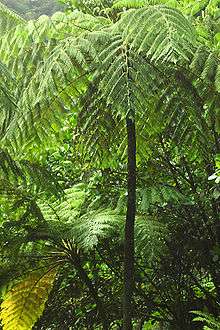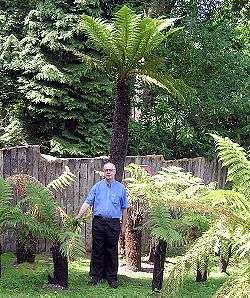Tree fern
The tree ferns are the ferns that grow with a trunk elevating the fronds above ground level. Most tree ferns are members of the "core tree ferns", belonging to the families Dicksoniaceae, Metaxyaceae, and Cibotiaceae in the order Cyatheales. This order is the third group of ferns known to have given rise to tree-like forms. The two others are the Marattiales, a eusporangiate order that the extinct Psaronius evolved from, and the order Polypodiales where the extinct genus Tempskya belongs.[1]

In addition to those families, many ferns in other groups may be considered tree ferns, such as several ferns in the family Osmundaceae, which can achieve short trunks under a metre tall, and particularly ferns in the genus Cibotium, which can grow ten metres tall. Fern species with short trunks in the genera Blechnum, Calochleana, Cnemedaria, Culcita (mountains only tree fern), Cystodium, Leptopteris, Lophosoria, Sadleria, Thyrsopteris and Todea could also be considered tree ferns in a liberal interpretation of the term.
Range
Tree ferns are found growing in tropical and subtropical areas worldwide, as well as cool to temperate rainforests in Australia, New Zealand and neighbouring regions (e.g. Lord Howe Island, etc.). Like all ferns, tree ferns reproduce by means of spores formed on the undersides of the fronds.
Description
The fronds of tree ferns are usually very large and multiple-pinnate. Their trunk is actually a vertical and modified rhizome,[2] and woody tissue is absent. To add strength, there are deposits of lignin in the cell walls and the lower part of the stem is reinforced with thick, interlocking mats of tiny roots.[3] If the crown of Dicksonia antarctica (the most common species in gardens) is damaged, it will inevitably die because that is where all the new growth occurs. But other clump-forming tree fern species, such as D. squarrosa and D. youngiae, can regenerate from basal offsets or from "pups" emerging along the surviving trunk length. Tree ferns often fall over in the wild, yet manage to re-root from this new prostrate position and begin new vertical growth.
Species

It is not certain the exact number of species of tree ferns there are, but it may be closer to 600-700 species.[4] Many species have become extinct in the last century as forest habitats have come under pressure from human intervention.
Location of species
Lophosoria (tropical America, 1 species)
Metaxya (tropical America, 1 species)
Sphaeropteris (tropical America, India, Southeast Asia to New Zealand, the Marquesas, and Pitcairn Island, about 120 species)
Alsophila (pantropic area, about 230 species)
Nephelea (tropical America, about 30 species)
Trichipteris (tropical America, about 90 species)
Cyathea (tropical America, about 110 species)
Cnemidaria (tropical America, about 40 species)
Dicksonia (tropics and southern subtropics in Island Southeast Asia, Australasia, America, Hawaii, St. Helena, about 25 species)
Cystodium (Island Southeast Asia, 1 species)
Thyrsopteris (Juan Fernández Islands, 1 species)
Culcita (tropical America, Azores, Island Southeast Asia, Australasia, about 7 species)
Cibotium (Southeast Asia, Hawaii, Central America, about 12 species)
References
- Convergent Evolution: Limited Forms Most Beautiful
- Trends and concepts in fern classification - NCBI
- Stem - The University of Auckland
- McGraw-Hill encyclopedia of science & technology. 18 (11th ed.). New York: McGraw-Hill. 2012. p. 642. ISBN 978-0071792738. OCLC 785808931.
External links
- Flora Technical Note No. 5: Identification and management of tree ferns from Tasmania Forest Practices Authority
- Tree Fern from the San Diego Zoo website